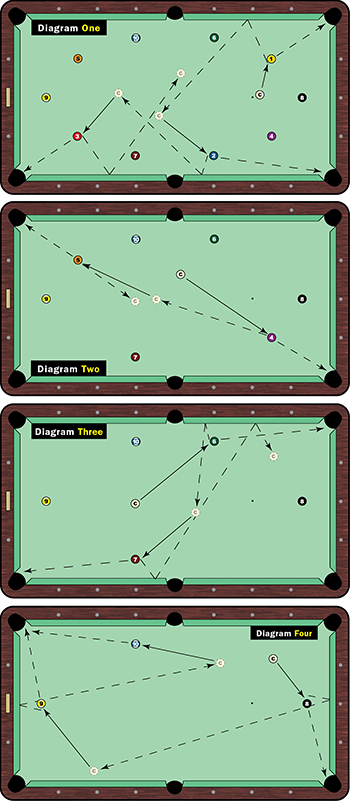The Oval Drill forces you to stay in the middle of the table.
Obviously, maintaining an angle on your next shot is critical for position play in rotation games. Here is a great little drill that is easy to set up and is good for every player from league player to pro level.
This drill puts a premium on using the center of the table. Itís a great drill to help when the balls are well spread out. On some shots, no rails are needed. Just, perhaps, some soft draw. Even the one-rail shots are primarily punch shots. The only time you should need a two-rail shot is if you get a little out of line on one of the balls.
Like most drills, you can make minor adjustments in the rules to increase the difficulty. In this drill, start with ball in hand and run the balls in rotation, no rails are required. To make the drill more difficult, add a one-rail requirement to each shot. In either case, you are not allowed to bump another ball.
One of the keys here, as is the case after any foul in a rotation game, is the placement of the cue ball for your first shot. I continually see amateur players take ball in hand and place the cue ball in a spot fraught with potential problems. In this case, I see players set up a straight-in shot on the 1, with the intent of drawing the cue ball back for the 2. The problems here are that you can come up short and have no shot on the 2 or draw back too far and get hooked behind the 7. You could also draw back directly into the side pocket. Thatís three potential pitfalls on your very first shot.
I prefer to set up the shot as shown in Diagram One, hitting the shot soft with lots of left English and letting the cue ball do all the work. This is a much better option for avoiding trouble.
From the center of the table, the 2 ball is just a soft draw with a little right English. This shot makes the pocket play bigger and should come nicely just past the center of the table.

Again, on the 3 ball just punch the shot with just a touch of left to get back to the center of the tables. In this case, landing straight on the 4 ball or 5 ball isnít a problem because youíre simply drawing back to the center of the table for both shots.
Staying in the center of the table is so beneficial. Itís always helpful to keep the cue ball off the rails and enjoy all the options that come with getting your hand on the table. Lots of freedom.
The 6 is a little punch shot, coming across to the middle of the table for the 7. You can use a center ball or a little left, whichever is more comfortable.
The 7 is the key shot. There really isnít a one-rail option because you risk coming up short or scratching in the bottom corner pocket.
I like a one-rail shot from the 8 to the 9, playing high center and letting the cue ball float down to the middle diamond on the long rail. A touch of right will eliminate a scratch in the corner if you overhit the cue ball.
Just stay still and use high center on the 9 ball. A touch of right will make the pocket play a little bigger. The transferred spin will help the 9 if it catches a little of the bottom rail on its way to the pocket.
As always, use a touch of draw or punch stroke on the 10. Iím always afraid of rolling the ball in because of the possibility of the ball skidding.
This drill will help improve your pattern play. Always try to beat your previous effort. This also allows for some freedom and creativity if youíre not perfect on every shot. Few players are.





